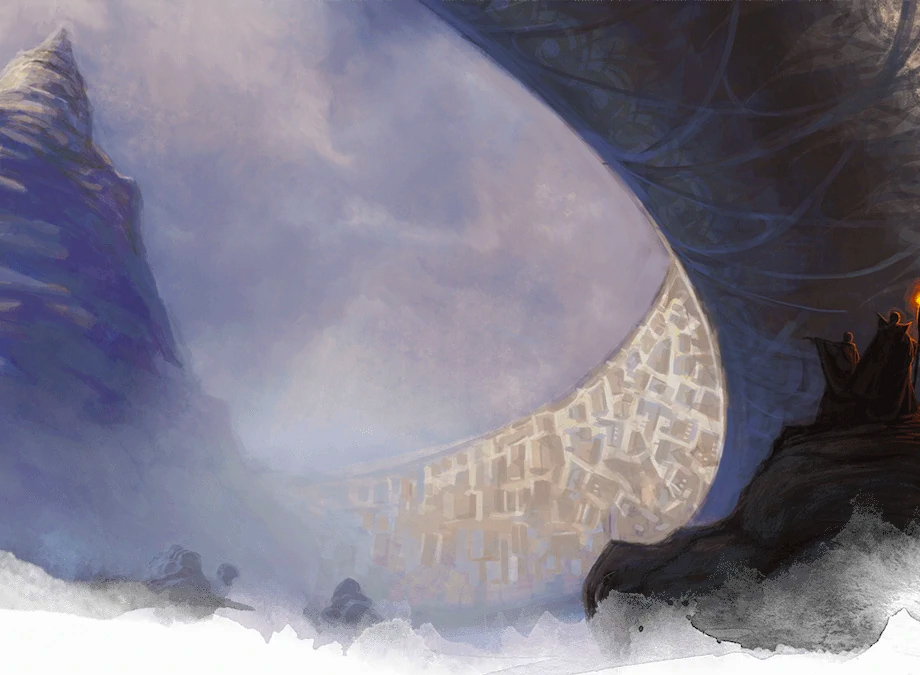With the upcoming release of Journeys Through the Radiant Citadel, we have a brand new locale to explore floating in the midst of the Ethereal Plane.
This, however, is not the first city that we’ve seen between the planes. There was once a city that sat between the planes of good and evil, between law and chaos. In fact, from a certain perspective, it was at the middle of the universe itself.
Welcome to Lore-Win, the Dungeons and Dragons lore series. I, as always, am your humble Loremaster, Sokar. Today we’ll be taking a look to the past before our journey to the future. A look back to the jewel on the crown of the Planescape. It’s the domain of the Lady of Pain, the city at the center of everything, and the home of many adventures of the realm.
I speak of Sigil, the city of doors!
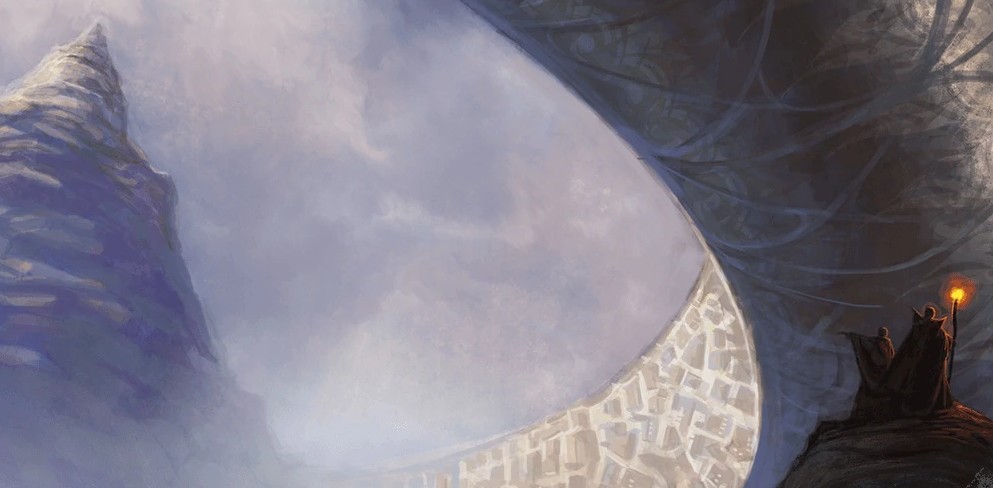
And a big old ring in the sky!
Source: Dungeon Master's Guide (5e)
A Note On Cosmology
But before we talk about Sigil, we have to talk about Planescape. And before we talk about Planescape, we have to talk a little about the cosmology of Dungeons and Dragons.
Now, no doubt you know of the planes. There are elemental planes, negative and positive energy planes, planes of law and chaos, of good and evil, the material plane, and the astral plane.
And those are just off the top of my head.
But how do these planes interact? How are they structured and arranged? That is the point of this discussion of cosmology and you might be surprised to hear that there is no single answer to these questions.
Instead, there are three.
These are the World Axis, the World Tree, and the Great Wheel, all of which display the arrangements of the planes throughout the different editions of Dungeons and Dragons. In the days of Planescape, the Great Wheel was the go-to-cosmology, and it is this multiverse which contains the city of Sigil. So, naturally it is also the cosmology that we will be exploring.
In this Great wheel, all the planes of existence were layered as concentric circles within a, as the name may imply, great wheel. This was split into two general categories, the inner planes, and the outer places.
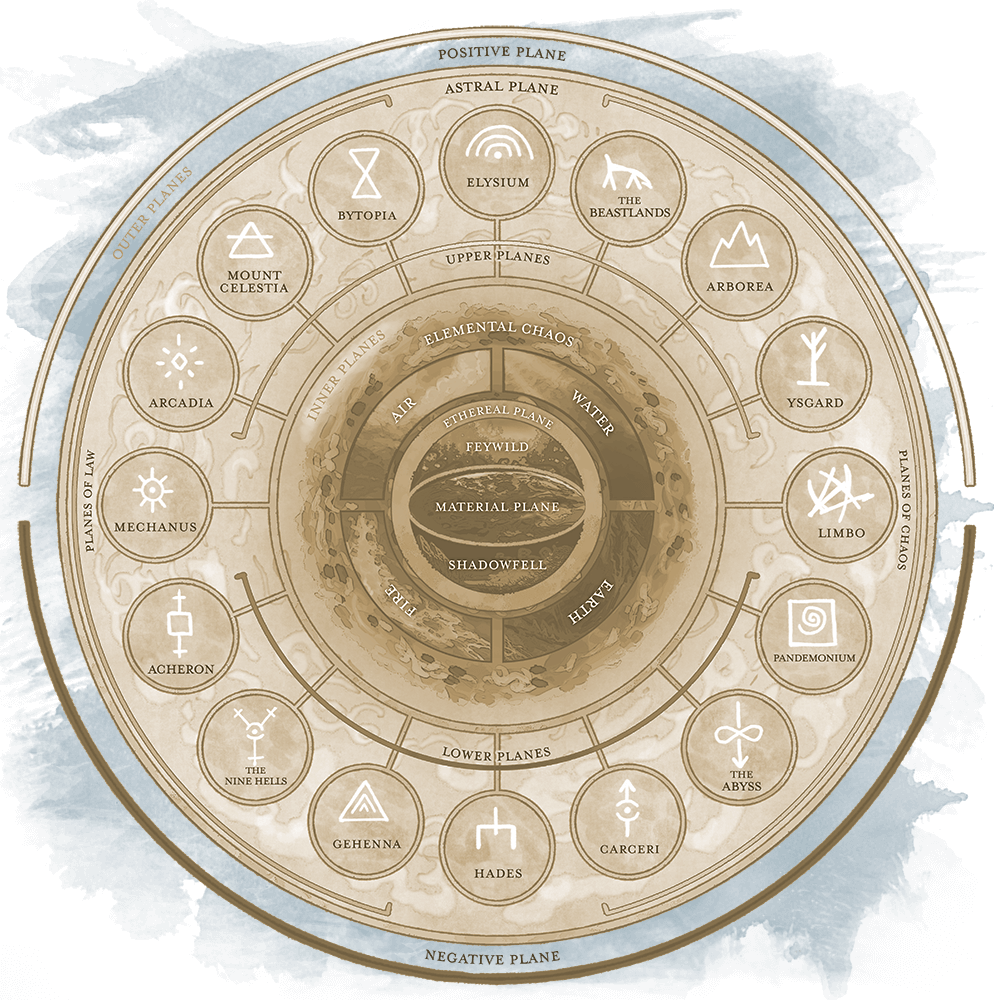
The Great Wheel, visualized.
Source: Player's Handbook (5e)
At the outermost layer were your energy planes, positive on the top and negative on the bottom. Then, moving in, we find the Astral Plane. Within this were all the corners of the alignment matrix: Law, Good, Chaos, Evil, and of course, Neutral. Each of these planes occupied a space in the ring that is the Astral Plane, like a compass of sorts.
Moving in, past the Astral Plane, we enter into the Inner Planes. Here we first find Elemental Chaos. This is a strange place where all the elements combine, though at the time little was known of it. A layer deeper we find a ring containing the Elemental Planes: Earth, Water, Fire, Air.
Beyond the elements is the Ethereal Plane, and then within that are the Feywild, the Shadowfell, and between the two, the Material Plane where mortals live and carry out their daily business.
But, returning to those Outer Planes is a realm of true neutrality, a plane that touches all the others. This is the Outlands, an infinite plane that stretches in every direction. And yet, it has a center, a definitive center. And in that center there is a great Spire that stretches higher and higher still.
At the outer rim of this infinite plane are sixteen towns, evenly spaced, each connecting to one of the Outer Planes. And at its center, atop the Spire, is a city.
A city known as Sigil.
Sigil’s Inhabitants
The origins of Sigil are not worth going into. Not because they aren’t interesting, I’m sure they must be. But the issue is, nobody knows the origins of Sigil.
Or, at least no one who seems particularly inclined to discuss them.
Ask your gods and demigods, contract with your Warlock patrons, for Sigil has existed for longer than any of them. In fact, Sigil has existed for as long as anyone can recall. And in all that time it has had permanent residents: The dabus, and the Lady of Pain.
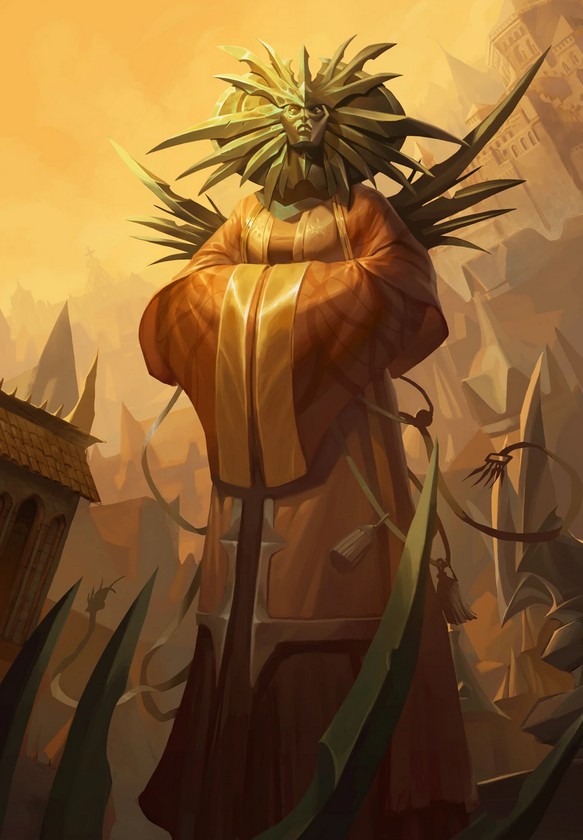
The Lady of Pain, in all her glory.
And by glory, I mean those spikes are functional.
Source: Planescape: Torment: Enhanced Edition
For as mysterious as Sigil is, the Lady of Pain is its equal. She is an enigmatic figure in a mask adorned with sharp blades and wearing red robes. She is undoubtedly the ruler of Sigil. After all, the city responds to her, and can be changed by her will alone. But she does not seem to care for the common folk or their squabbles. Indeed, she seems to care not for them at all.
The Lady of Pain does not talk to others, and it is unwise to draw her attention. There are stories about how those she looks upon find their flesh to be swarmed with blood wounds. There are also tales of those who get her attention being trapped within great mazes… or worse.
The worst kind of attention one may draw from the Lady of Pain is by worshiping her. While she may certainly wield god-like abilities, she has made it clear that she has no desire to be worshiped. How has she made this message clear?
By flaying alive any who try.
It’s not hard to see why some may try, though. When you live inside a donut-shaped city that expands and shrinks at the whim of a seemingly-immortal woman who can wound you at a glance, it certainly sounds like you live in the domain of a goddess. Plus, Sigil has the title of “The City of Doors” for a reason.=
Namely, that it is filled with portals to other Planes, and these portals can be opened or closed to anyone at the Lady of Pain’s whim. So there’s another godlike ability she holds over the city. The Lady of Pain only truly intervenes in matters that might upend the stability of Sigil. She bars divine powers from entrance, though allows their servants entry. Her most direct involvement have been in internal disputes and power grabs, often to reinforce her position and put an end to groups who seek to seize control of Sigil.
Sigil’s other permanent residents are the dabus. These are a humanoid race who appear to be solely found in the city of Sigil with white hair and goatlike horns. The dabus never speak, but instead communicate through symbols that appear around their heads. They can, however, understand speech.
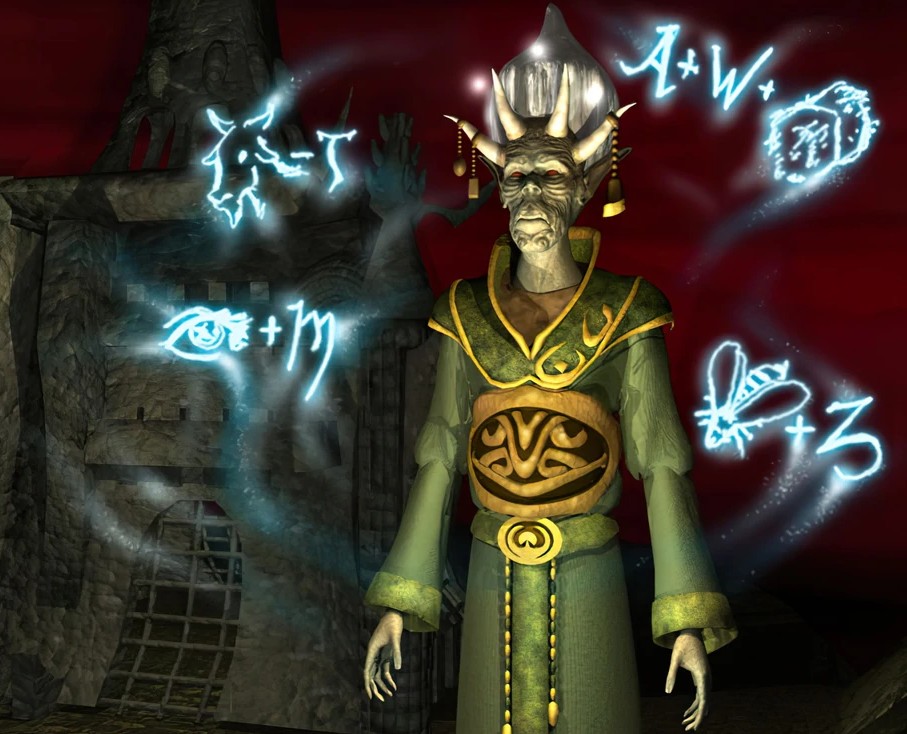
A dabu, surrounded by the symbols by which they communicate.
Source: Planescape: Torment
Dabus also never walk, instead hovering inches off the ground. Like the Lady of Pain, they have been in Sigil for as long as any can remember. Some believe they are the original inhabitants of the city, others believe that they were created by the Lady of Pain herself. Whatever the case, they tend to the city fondly, repairing it when damaged. Or destroying and rebuilding structures as needed. They have never been seen beyond Sigil, leaving some to conclude that they simply cannot leave the city.
Dabus also have a connection to the Lady of Pain, acting as her personal entourage. While they are much more patient than she is, interrupting their work is still a risky act. It might draw the Lady of Pain’s attention, and that has dire consequences.
Beyond these, Sigil counts every race imaginable among its inhabitants. As both a central location in the planes, and a city filled with portals to every plane, it sees swathes of souls passing through. Elves, humans, demons, gith, and celestials alike live and work in this city.
Though, not always by choice.
Sigil Itself
As mentioned, Sigil is full of portals that lead to every plane in existence. For some, this is undoubtedly useful. After all, it allows travel and trade to anywhere in the multiverse. But, of course, there’s also the potential for unintentional travel.
Every single door, gate, arch, and picture frame could be a portal in Sigil. Portals that can lead to random locations among the planes, including other points of Sigil itself. And to frustrate matters even more, those portals can be temporary. This makes it extremely annoying to both enter and leave the city.
This has led to another nickname for Sigil, “The Cage”. And locals call themselves “Cagers”.
In terms of appearance, Sigil was shaped like the inside of a torus. Or rather, it was the inner curve of a donut-like shape. This results in a looping city that you could walk through the streets of forever.
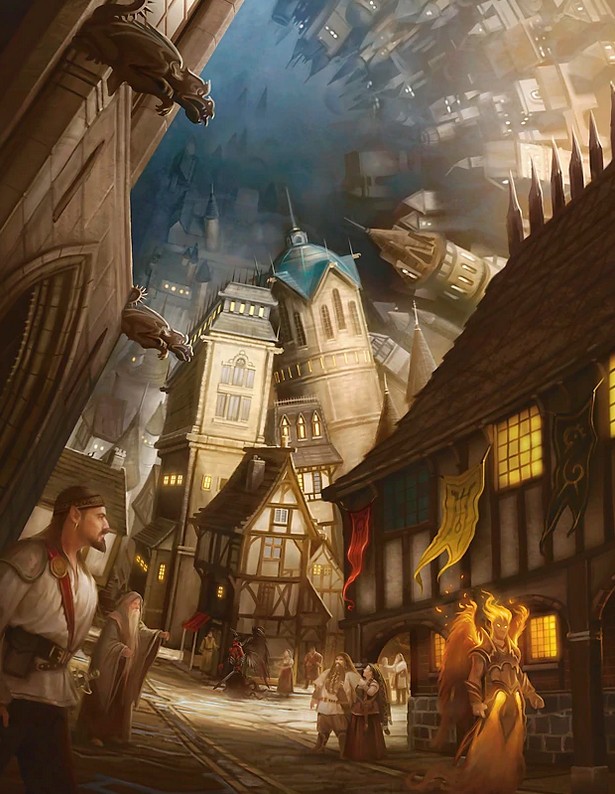
They go on and on and on...
Source: Dungeon Master Guide 2 Art Collection (4e)
The skyline of Sigil is also unique. By that I mean, Sigil doesn’t have a skyline. So, good luck adjusting to a clear sky after living there for a while.
In terms of districts, Sigil is organized into six (or five, depending on who you ask) different wards. The Market Ward is fairly obvious. This is effectively the shopping district, with goods from every plane conceivable available for sale. Then there’s the Guildhall Ward. This is where you can find traders, tradespeople, artisans, crafters, and guild members. Some count it as just an extension as the Market Ward, while others view it as a separate district.
Next up is the Clerk’s Ward, where lower and middle-level bureaucrats live. The Hive is where the slums and ghettos lay. This is where the poor, the unwanted, and the rogues of the city live. Sigil also boasts an industrial ward: The Lower Ward. This is both where the city’s industrial heart is, and also where Sigil connects to the lower planes. Soot and smoke clogs the air here, at least partially from the portals leading to the Hells.
The Lady’s Ward is where the rich and elite live. This is where figures in the government live, and yes, Sigil does have a government. At the head of that government, the Lady of Pain rules over Sigil uncontested. It is by her whim that Sigil reshapes itself and the portals open and close. She keeps gods and archfiends out by will alone, and so she sits on the Throne of Blades.
However, as the Lady of Pain does not care about the day-to-day runnings of the city or the lives of those within it, Sigil has occasionally developed other forms of government. At one time, the city was ruled by guilds. However, with 50 guilds warring for control, the conflict reached a point where the Lady of Pain took notice and intervened.
Following this, the Lady of Pain allowed 15 factions to operate the city. However, after around 600 years, these factions began a war for control of the city, known as the Faction War. Unfortunately for them, this drew the Lady of Pain's gaze.
When she finished, no factions remained in Sigil. The city now exists on the edge of anarchy, kept as a truly neutral city. However, the Lady of Pain and her dabus only care for larger scale events. Without a government, “petty” crimes like murder and muggings go unpunished.
However, at least one other has attempted to take control of Sigil. The lich (and later god) Vecna attempted an invasion of Sigil. He hoped to use SIgil to take control over the whole of the multiverse. Of course, this was a large enough event that the Lady of Pain intervened. She teamed up with parties of adventurers, and combined their efforts pushed back Vecna’s attack.
Since then, the Lady of Pain has reorganized the Sigil and reinforced its defenses. A clear attempt to keep anything so drastic from happening again.
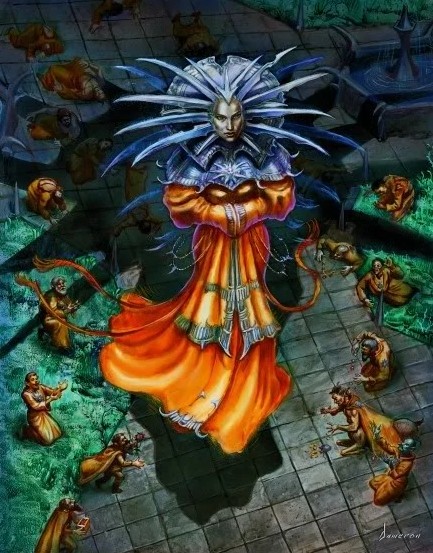
If it wasn't clear, let me say it bluntly.
Do not mess with her.
Source: The Planeswalker's Handbook (AD&D 2nd Ed)
Sigil is quite possibly one of my favourite locales in all of D&D. I think it’s a perfect place in any multiverse-spanning campaign, and a great place to introduce higher level parties to. Plus, if you’re a wizard, there’s probably no better place to get spell components from. Especially the rare ones.
And if you’re looking for a different cosmic city to explore, be sure to pick up Journeys Through the Radiant Citadel at the Tower!
Until next time, may all your rolls be crits.
-Loremaster Sokar

